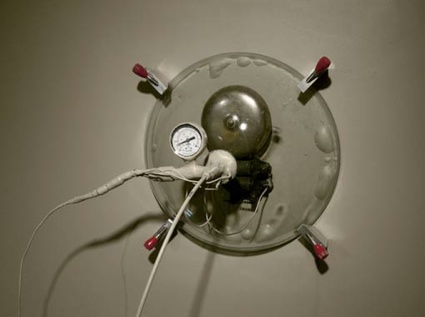 Michel de Broin, Silent Screaming, 2006
Michel de Broin, Silent Screaming, 2006
Michel de Broin hung a gigantic disco-ball over Paris, threw 12 tons of asphalt on the road to create a absurdly twisted bike lane in Montreal, rode his polluting bicycle in parks, knitted New Orleans street lamps into a satellite-shaped structure, silenced an alarm bell under a vacuum system and famously got his pedal-powered 86′ Buick Regal car pulled over by the police.
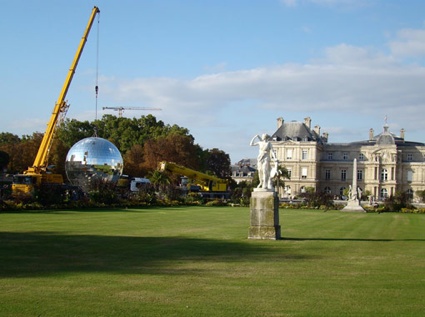
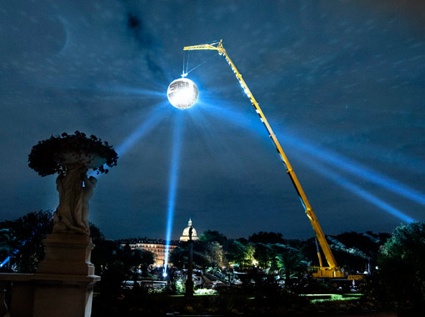 Michel de Broin, La Maîtresse de la Tour Eiffel, 2009
Michel de Broin, La Maîtresse de la Tour Eiffel, 2009
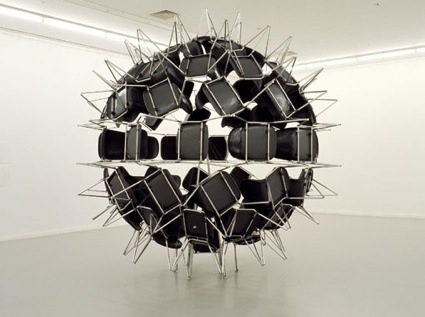 Michel de Broin, Black Whole Conference, 2006
Michel de Broin, Black Whole Conference, 2006
Michel de Broin lives between Berlin and Montreal. I’ve seen his work in Spain, Belgium, Germany. I read about it in catalogues and other books about urban art and public art. The more i saw of his work, the more i wanted to interview him. Hence the following Q&A:
I’m very curious about the way you work. You graduated in visual art at Université du Québec, in Montréal. But looking closer at your artworks, it appears that they require the kind of knowledge that most art program do not teach such as a knowledge of mechanics and engineering.
I’ve never seen an artist succeed at simply applying knowledge learnt from school. Ideally art schools are not simply technical; you don’t learn a skill in art school. But each student develops specific skills from their interests. You learn to learn, and you discuss a lot. Like many others, I was not good at high school and I was kicked out of 2 before attending art school where things changed and I began to be successful because you are asked to think for yourself and make your own work.
When I was a kid, I was doing mechanics and electronics and a lot of funny things playing with found objects in the garbage. I hated high school so much, but I was not a problem at home because I was helping my father, who was handicapped, round the house; doing a lot of things at a very young age like using power tools and fixing appliances. So I inherited all these tools from my father, and I was then able to build tree houses, go carts and caves. My older brother was studying mathematics and was playing with electronics. Nothing fancy, but I remember we installed an alarm system in our bedroom to prevent adults from getting in. I don’t remember learning anything; I was just looking outside and playing with what was around me. I was hostile to institutions, schools and adults in general, and so I was more inclined to do things by myself.
So how do you handle the crafting/building/hacking/engineering of each of your projects?
I’ve been growing since then, and I now do big things with serious people. When it is a public commission I need an engineer to sign my drawings, I prefer to work with an engineer who lets me do my work and does not get stressed about the consequences. But you normally need good insurance to play outside, and fortunately I have worked with some very helpful people.
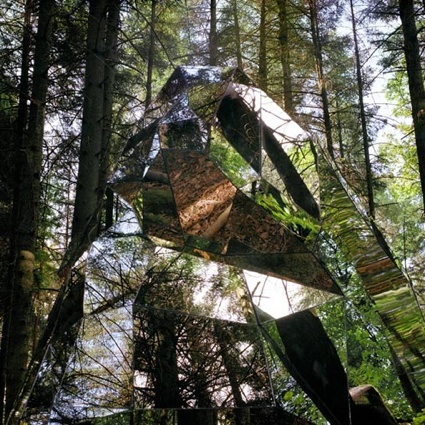 Michel de Broin, Superficial, 2004
Michel de Broin, Superficial, 2004
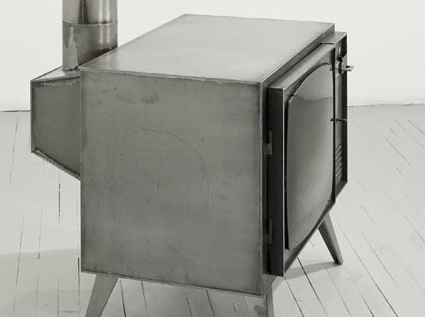 Michel de Broin, Late Program, 2009. A television functioning as a wood burning stove
Michel de Broin, Late Program, 2009. A television functioning as a wood burning stove
Do you rely on the expertise of other people, like Carsten Holler or Takashi Murakami do?
I’m not working at the same scale. But still there is sometime friends, technicians, and collaborators working or answering my questions. The most difficult is not the technical aspect of the project but to have a project interesting enough to keep my attention for the duration, generate the resources involved, and also to induce the will to make it happen.
Or do you do have a more hands-on approach, acquiring the expertise yourself and experimenting?
I like to learn new skills when I’m experimenting, and refuse to rely on experts. But I’m very grateful to experts from whom I can learn something or share some knowledge with. Making art is more difficult than solving problems, but problems are generative and can contribute to creating new thought.
And why this choice (relying on other experts vs going through the trouble of DIY)?
It is part of the process to work through problems, I need a confrontation with the world to be able to create an outcome. But it doesn’t need to be technical; it can be emotional, social, philosophical… It depends on where I address my work. Most of the time I use devices that were made by others. I sometime question how it would be if I was making all the objects that surround me. Making a light bulb seems like very hard work, I would guess it could take me almost a year to make one functional light bulb, and only if I could have access to existing technology. But if I had to go mining for the tungsten, and make everything from scratch, I don’t think a whole lifetime would be enough to create a light bulb.
Few artists make their own canvases, collect their pigments from plants, or collect the silicone to power the microprocessor of their computer. Duchamp would say that we are all doing readymade, applying a very low level of transformation to the manufactured object of our appropriation. It is as true for the images, the language, and the tools we are using, they were developed over time and I arrived afterwards. Most things already exist before we figure them out, and being able to draw an image doesn’t mean it belongs to us. The origin is very far behind and very difficult to claim.
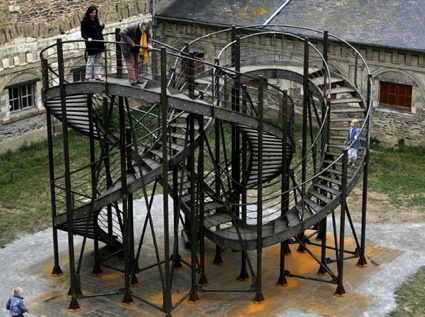 Michel de Broin, Revolution, 2010
Michel de Broin, Revolution, 2010
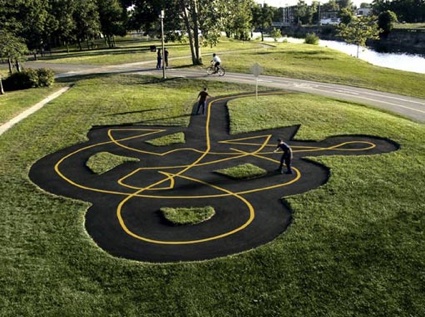 Michel de Broin, Entrelacement, 2001
Michel de Broin, Entrelacement, 2001
Some of your work deals with a progress and progression that goes awry: stairs that are supposed to lead you up but end up leading you to your point of departure, road signals that confuse you, roads that go nowhere, etc. Do these works translate a cynical or pessimistic vision of where the world is going? Or are they about something else?
This is your interpretation, I’m trying to not have any moral value about how things should or should not be. For more than ten years, I have been building stairs as infinite paths of circulation, extracted from architecture and stripped from all functionality. I think they raise the question of progress by showing how things rise and fall in a continuous cycle, like living species, bringing my understanding of natural processes against a dated modern belief in progress.
In Entanglement 2001, I created a cycle path inspired by abstract gesture, but represented at the scale of the urban landscape. The freehand drawing defies the rationality of the public planning. It is not about confusion but about having a different experience other than rationalism in the public space. I’m optimistic, even in my pessimistic vision, because I need to believe in something to make it work in reality.
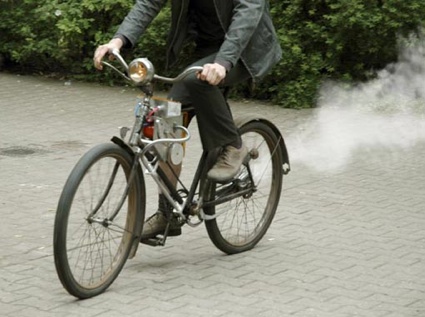 Michel de Broin, Keep on Smoking, 2006
Michel de Broin, Keep on Smoking, 2006
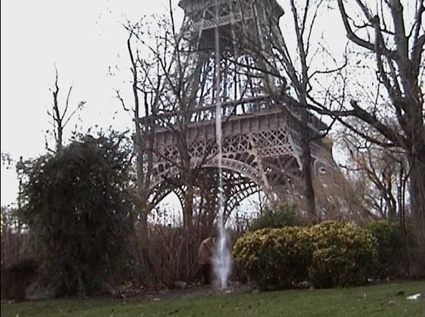 Michel de Broin, Reparations, 2006
Michel de Broin, Reparations, 2006
Works such as Shared Propulsion Car, Reparations and Keep on Smoking take art outside of the museums and into the streets. Is that so just because of the nature of the work or because you want to engage with the public in a different way? or with a public that might otherwise not enter a museum or art gallery?
The public is not my concern; I’m interested in art. Sometimes it is fun to please the public, but it is different to making something that makes sense in art. My public interventions were not ‘spectacles’ where the public was invited. It was more a kind of experience of the outside, a test for the object itself that could be perceived as a gentle act of terrorism. I didn’t ask permission, but I didn’t break the law. No one was invited. They were isolated acts, documented and carefully collected and presented by galleries and museums.
It is on site that an opportunity of making sense appears. Then those occurrences can be brought into a studio, sampled, edited, deconstructed and transformed into works of art.
How did people react to Keep on Smoking?
Some people love it, some people hate it. There is a good articale from Bernard Schutze, available online at this address http://www.micheldebroin.org/text/2006_schutze_en.html
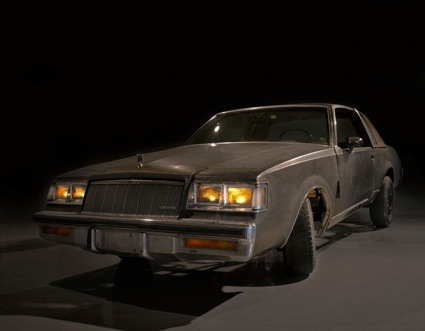
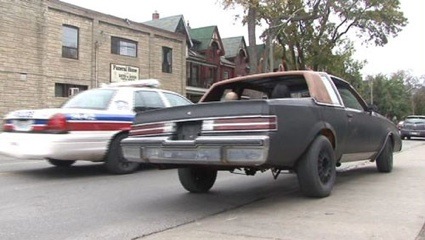
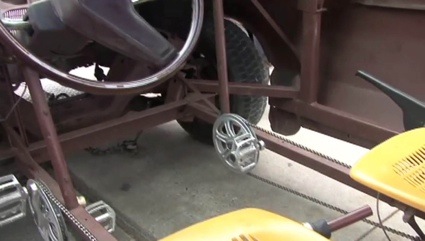 Michel de Broin, Shared Propulsion Car, 2005
Michel de Broin, Shared Propulsion Car, 2005
The Shared Propulsion Car went through some misadventures. It was pulled over by the police in Toronto. Did the brush off with the law go any further?
This car seems wrong from a normative point of view. The police were fooled by the successful illusion I created. There is noting against pedaling a car in the law, there was no reason for the arrest. For the police it is illegal to modify a car, but what happens when you modify it until it is not a car anymore? A car is defined by its engine, with no engine there is no car, and there is no cause. I knew this before taking it out onto the road, but I also knew that there were some risks, luckily the judge could see clearly in this case.
Have you driven the vehicle in other cities?
New York (USA), Toronto (Canada), Montreal (Canada), Poitier (France) now it is part of a French collection in Angoulême.
The video, recorded by Benny Zenga, documents the Shared Propulsion Car in motion, October 27, 2007
And were you expecting or maybe even hoping for the police to stop you? Maybe to appear in the newspaper and get a discussion going about car culture?
If an object creates new perception it risks creating problems and misunderstanding. I like to try to make the impossible possible, because it is a sign of the presence of the art for me. When we look at history we see that some of the good art confronts the mind and takes time to be accepted.I got a lot of attention from media, there were 15 journalists in the courtroom, and it was interesting to see how an art project can create a discussion outside of the art world. But I got tired of answering questions from journalists that made no research and were misinformed. It is very boring to deal with the mainstream media.
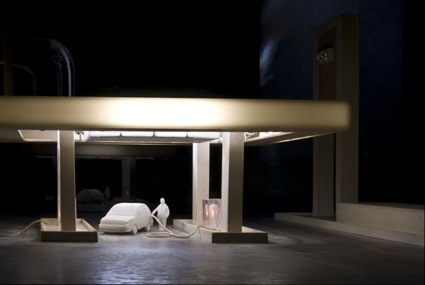
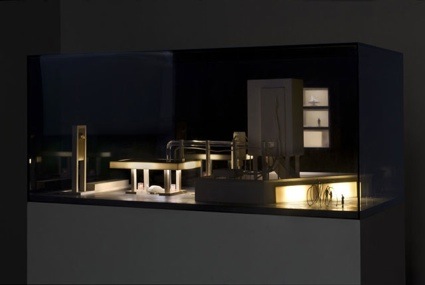 Michel de Broin, Station (from Reciprocal Energy), 2003-08. Model for a liposuction clinic directly related to a gas station where the human fat will be resold as anthropo-diesel fuel
Michel de Broin, Station (from Reciprocal Energy), 2003-08. Model for a liposuction clinic directly related to a gas station where the human fat will be resold as anthropo-diesel fuel
Reciprocal Energy is a fascinating work. The project speculates that the automobile could acquire its energy directly from the body fat of its driver. It looks like an ambitious scientific research verging into dystopian territory. What was the inspiration for it? Is it pure imagination or are elements of it based on some scientific research?
The human body can be compared to a machine that transforms ingested food into energy. If a surplus of food is ingested, the energy is stored in the form of fats in the adipose tissue beneath the skin. However fats can be transformed into fuel through an chemical process. The procedure consists of removing the suspended water in order to trigger a chemical reaction known as transesterification, which entails the extraction of glycerine. A chemical reaction is obtained through the conveyance of methanol alcohol (CH4O) and caustic soda (NaOH). The resulting fuel is comparable to diesel fuel.
Why not recuperate the stored fat extracted in liposuction clinics in order to transform it into biodiesel and use it as a fuel? The conversion of the fat into fuel would make it possible to recover the potential energy, which is otherwise merely incinerated or dumped into the environment.
This project seeks to draw attention to a particular problem: the fact that automobile drivers and their automobiles are not yet sufficiently well assembled. In effect, when the human body uses a machine, it economises a certain quantity of energy. The energy provided by the ingestion of food is then stored in the form of fats. At the same time as the automobile driver stores energy and accumulates fat, the automobile consumes fossil fuel and wastes energy resources. Why not couple man and machine in order to resolve both the problem of obesity and the energy crisis, while also providing an ecological alternative?
This coupling would make possible an intimate reciprocity between man and machine. Moreover, the use of fat as a fuel would contribute to resolving the problem of which it is itself a symptom by maintaining the resource both renewable and accessible.
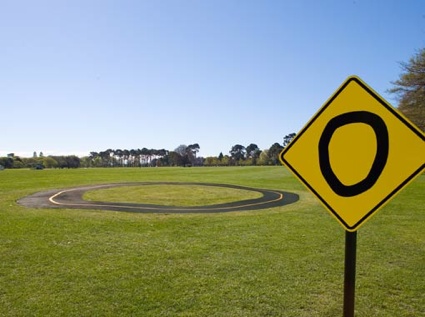 Michel de Broin, Encircling, 2006
Michel de Broin, Encircling, 2006
Any upcoming works, exhibitions, projects, or events you could share with us?
Retrospective at the Musée d’art contemporain of Montreal, summer 2013 (with a Catalogue)
Installation of a permanent public sculpture in Berlin in the German parliament in 2014.
Installation of a permanent public sculpture at the National Gallery of Canada.
Merci Michel!
